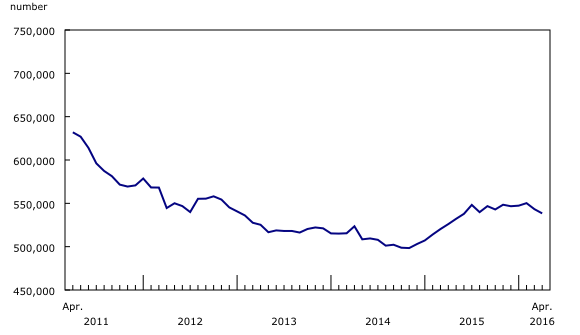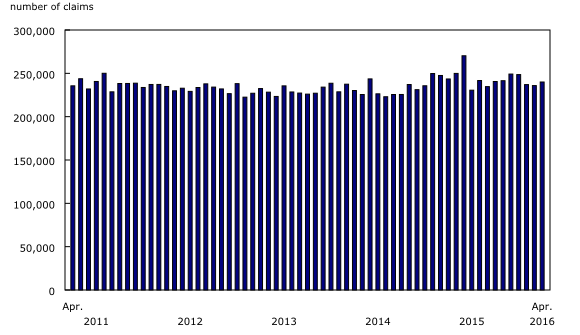Employment Insurance, April 2016
Archived Content
Information identified as archived is provided for reference, research or recordkeeping purposes. It is not subject to the Government of Canada Web Standards and has not been altered or updated since it was archived. Please "contact us" to request a format other than those available.
Released: 2016-06-23
In April, 538,400 people received regular Employment Insurance (EI) benefits, down slightly from the previous month (-4,900 or -0.9%).
The number of EI beneficiaries decreased in five provinces in April, most notably in Ontario (-2.4%), British Columbia (-2.2%) and Newfoundland and Labrador (-2.0%). There were also fewer beneficiaries in Saskatchewan (-1.7%) and New Brunswick (-1.5%). On the other hand, the number of recipients increased in Alberta (+1.2%) and Prince Edward Island (+1.0%). Little change was observed in the remaining provinces.
On a year-over-year basis, the total number of EI beneficiaries in Canada was up by 12,400 or 2.4%, mainly as a result of increases that occurred early in the summer of 2015.
Changes in the number of regular EI beneficiaries reflect various situations, including people becoming beneficiaries, those going back to work and those no longer receiving regular benefits.
Provincial and sub-provincial overview
In Ontario, 137,600 people received EI benefits in April, down 2.4% from March. There were fewer beneficiaries in 10 of the 15 census metropolitan areas (CMAs), with decreases ranging from 6.4% in Peterborough and Thunder Bay to 1.4% in Greater Sudbury and Hamilton. Windsor (+5.1%) and Kitchener–Cambridge–Waterloo (+1.1%) were the only CMAs in Ontario with an increase in beneficiaries.
The number of EI beneficiaries in British Columbia decreased by 2.2% in April to 50,500. Virtually all of the CMAs and some of the census agglomerations (CAs) in the province reported declines, with the largest being in Vancouver (-3.7%) and Kelowna (-3.5%). The number of recipients in British Columbia has been on a downward trend since August 2015.
Newfoundland and Labrador had fewer people receiving EI benefits in April, down 2.0% from March to 33,100, with the largest decline occurring in areas outside of St. John's and the CAs. On a year-over-year basis, however, the number of beneficiaries in the province increased by 2.7%.
EI beneficiaries in Saskatchewan numbered 16,400 in April, a 1.7% decrease from the previous month. Declines occurred throughout the province, including Regina (-2.4%) and Saskatoon (-1.1%). In the 12 months to April, the number of beneficiaries in Saskatchewan increased by 26.9%.
Fewer EI beneficiaries were reported in New Brunswick, down 1.5% in April to 32,600. Declines were observed throughout the province, including Moncton (-2.1%) and Saint John (-1.5%). On a year-over-year basis, the number of beneficiaries in New Brunswick was essentially unchanged.
In Alberta, 67,900 people received regular EI benefits in April, up 1.2% from the previous month. Calgary (+1.0%) and areas outside of the CMAs and CAs (+2.9%) had more recipients, while other areas in the province were mostly unchanged. On a year-over-year basis, the number of beneficiaries in Alberta increased by 52.2%.
The number of EI beneficiaries in Prince Edward Island rose slightly (+1.0%) in April to 7,800. On a year-over-year basis, the number of beneficiaries in the province grew by 7.7%.
While the number of EI beneficiaries in Nova Scotia, Quebec and Manitoba was little changed in April, this was not the case for some areas within these provinces.
In Nova Scotia, Halifax (+1.4%) posted an increase. In Quebec, the CMAs of Québec (+1.3%) and Sherbrooke (+1.2%) rose, while Gatineau (-2.5%) declined. At the same time, in Manitoba, the areas outside of Winnipeg and the CAs (-1.1%) had fewer beneficiaries.
Employment Insurance beneficiaries in major demographic groups
In April, there was a slight decrease in the number of EI beneficiaries among men aged 25 to 54 (-1.3%) and women aged 55 and older (-1.0%). The other major demographic groups were unchanged.
In the 12 months to April, there were increases in all major demographic groups, except among women aged 25 to 54, who experienced a decline. The year-over-year gain in recipients was greater among men than women.
Employment Insurance claims
The number of EI claims totalled 240,000 in April, a 1.8% increase from the previous month. The number of claims provides an indication of the number of people who could become beneficiaries.
There were more EI claims in three provinces: Quebec (+5.7%), Newfoundland and Labrador (+5.6%) and Ontario (+4.6%). While Alberta had little change in the number of claims, the remaining provinces reported declines. Most notably, in Saskatchewan, the number of claims decreased by 15.7% in April.
Compared with 12 months earlier, EI claims were down 1.4% at the national level in April. This was the third consecutive month with a year-over-year decrease in claims.
Note to readers
Availability of data by occupation
Information on Employment Insurance (EI) beneficiaries by occupation will not be available until the completion of the reclassification of the administrative files to the 2011 National Occupational Classification (NOC) from the 2006 National Occupational Classification for Statistics (NOC-S).
As a consequence, the table, "Beneficiaries receiving regular income benefits by occupation," is not available in The Daily. In addition, CANSIM tables 276-0040 and 276-0041 cannot be updated and will be replaced by new CANSIM tables once the reclassification is completed.
Concepts and methodology
Regular EI benefits are available to eligible individuals who lose their jobs and who are available for and able to work, but cannot find a job. To receive EI benefits, individuals must first submit a claim. The number of claims provides an indication of the number of people who could become beneficiaries.
There is always a certain proportion of unemployed people who do not qualify for benefits. Some unemployed people have not contributed to the program because they have not worked in the past 12 months or their employment is not insured. Other unemployed people have contributed to the program but do not meet the eligibility criteria, such as workers who left their job voluntarily or those who did not accumulate enough hours of work to receive benefits.
All data in this release are seasonally adjusted. For more information on seasonal adjustment, see Seasonally adjusted data – Frequently asked questions.
EI statistics are produced from administrative data sources provided by Service Canada and Employment and Social Development Canada. These statistics may, from time to time, be affected by changes to the Employment Insurance Act or administrative procedures.
The number of regular EI beneficiaries and the number of claims received for the current and previous month are subject to revision.
The number of beneficiaries is a measure of all people who received EI benefits from April 10 to 16. This period coincides with the reference week of the Labour Force Survey (LFS). However, initial and renewal claims data are for the entire month.
EI statistics indicate the number of people who received EI benefits and should not be confused with LFS data, which provide information on the total number of unemployed people.
Geographical definitions
A census metropolitan area (CMA) or a census agglomeration (CA) is formed by one or more adjacent municipalities centred on a population centre. A CMA, also referred to as a "metropolitan area," must have a total population of at least 100,000. A CA must have a population of at least 10,000. See Standard Geographical Classification 2011 – Definitions for more information.
Next release
Data on EI for May will be released on July 21.
Products
More information about the concepts and use of Employment Insurance statistics is available online in the Guide to Employment Insurance Statistics (73-506-G), from the Browse by key resource module of our website, under Publications.
Contact information
For more information, contact us (toll-free 1-800-263-1136; 514-283-8300; STATCAN.infostats-infostats.STATCAN@canada.ca).
To enquire about the concepts, methods or data quality of this release, contact Melissa Moyser (613-951-4027; melissa.moyser@canada.ca), Labour Statistics Division.
- Date modified:





